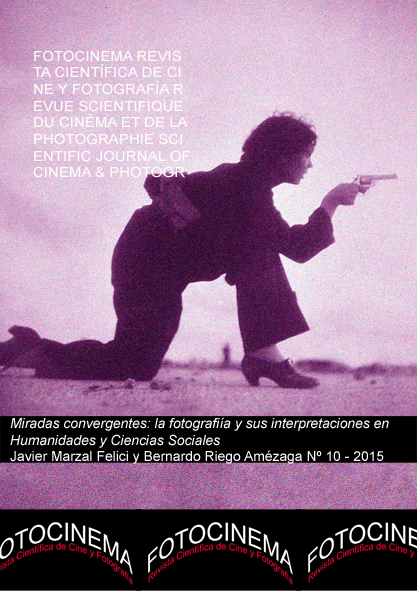Lo que el documento esconde. Prácticas conceptuales en la fotografía documental
DOI:
https://doi.org/10.24310/Fotocinema.2015.v0i10.5984Abstract
Resumen:Frente a la concepción tradicional del documentalismo, centrada en la mirada del fotógrafo, la transparencia de la imagen y la estructura narrativa, en los últimos años han ido surgiendo alternativas que buscan retomar los planteamientos de algunos de los pioneros del género, como Walker Evans o August Sander, y de la práctica de la fotografía en el ámbito del discurso científico. El llamado documentalismo conceptual combina estas prácticas con las aportaciones del arte conceptual en la década de los sesenta, dando lugar a un nuevo modo de entender la construcción del discurso visual sobre el mundo histórico.
Abstract:
Facing up the conventional idea of documentary, focused on the phtographer’s gaze, image transparency and narrative structure, last years have sought the arousal of new alternatives looking for resuming the principles of some of the photographers who pioneered the genre, like Walker Evans and August Sander, and the practice of photography in scientific discourse. The so called conceptual documentary combines these practices with the contributions of conceptual art in the sixties, resulting in a new way of understanding the construction of a visual discourse on historical world.
Palabras clave:
Fotografía; fotografía documental; arte conceptual; Bleda y Rosa; Xavier Ribas
Keywords:
Photography; Photografía documental; Conceptual Art; Bleda y Rosa; Xavier RibasDownloads
Metrics
Publication Facts
Reviewer profiles N/A
Author statements
Indexed in
-
—
- Academic society
- N/A
- Publisher
- Universidad de Málaga
Downloads
Published
How to Cite
Issue
Section
License
All contents published in Fotocinema Revista científica de cine y fotografía are protected under the Creative Commons Attribution-NonCommercial-ShareAlike 4.0 International (CC BY-NC-SA 4.0) license. All about this license is available in the following link: <http://creativecommons.org/licenses/by-nc-sa/4.0>
Users can copy, use, redistribute, share and exhibit publicly as long as:
- The original source and authorship of the material are cited (Journal, Publisher and URL of the work).
- It is not used for comercial purposes.
- The existence of the license and its especifications are mentioned.
There are two sets of authors’ rights: moral and property rights. Moral rights are perpetual prerogatives, unrenounceable, not-transferable, unalienable, imprescriptible and inembargable. According to authors’ rights legislation, Fotocinema. Revista científica de cine y fotografía recognizes and respects authors moral rights, as well as the ownership of property rights, which will be transferred to University of Malaga in open access. The property rights are referred to the benefits that are gained by the use or the dissemination of works. Fotocinema. Revista científica de cine y fotografía is published in an open access form and it is exclusively licenced by any means for doing or authorising distribution, dissemination, reproduction, , adaptation, translation or arrangement of works.
Authors are responsable for obtaining the necessary permission to use copyrighted images.














13.png)



